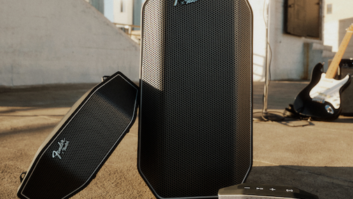Retailers will have plenty to peruse in the MP3-type music portables category, given all of the new entrants. Here’s a sampling of new products that will be displayed during International CES this week.
Archos: Mock-ups of the new AV500 series of HDD-based portable audio/ video players will be shown. Second-quarter delivery is targeted. Details were unavailable. The company already offers the AV300 series, which displays video transferred from a PC or recorded directly from a TV.
Auvi Technologies: The start-up, focused initially on sales through its Web site, www.auviworld.com, is launching its first three MP3 portables at the Digital Experience on the day before the show. All three play MP3 and WMA files, are firmware-upgradeable, and connect directly to a USB port without a USB cable. They can also be used as a device to transfer nonmusic files between computers.
The flash-memory SA100, available since December, does not support the WMA DRM, and plans for the next two models, due around mid-year, were uncertain. The 100 is PC/Mac-compatible and delivers six-hour play time from a single AAA battery. It’s available in three versions: $49.99 for 64MB, $79.99 for 128MB, and $99.99 for 256MB. Memory is built-in.
The A250 flash memory will be available with the same memory options but will add USB 2.0 connection speed, FM radio, voice recorder and MP3 encoder to directly record songs from CDs and from the internal FM tuner.
The SA1500 will offer the same features plus HDD, 160-by-105 back-lit display, and built-in lithium-ion battery.
Additional details were unavailable.
BenQ: The company’s first flash-memory portable is the 128MB Joybee 120, a multipurpose MP3/WMA/WAV/FM player, audio encoder and USB flash drive that stores nonmusic files such as PowerPoint presentations.
The 120 is expected to ship in late January at an estimated $159. Additional flash-memory portables are due in 2004 along with a HDD music portable, the company said.
The 2.2-by-1.5-by-0.45-inch device doesn’t support the WMA DRM, but future models will likely do so, a spokeswoman said. Its firmware, which can be upgraded, would allow for future codec and DRM upgrades.
The 120 records voice and FM stereo, features a USB 1.1 port, supports MP3 bit rates up to 320Kbps, and features a built-in lithium-ion battery that delivers about 15 hours of MP3 playback time. Other features include EL backlight display, seven EQ options, and three repeat playing modes. Weight is only 0.85 ounces, excluding battery. It comes in three metallic colors.
Because it plugs directly into a USB port, users can plug it directly into a video projector to make a PowerPoint presentation.
Creative Labs: The company is converting all of its Nomad flash-memory music portables to USB 2.0 from USB 1.1 to accelerate raw transfer rates from PC to portable to 480Mbps from 12Mbps. Creative will also adopt the WMA DRM in all new flash-memory and HDD music portables for compatibility with the growing number of authorized download services using the WMA DRM.
The first products to get USB 2.0 appear in the new Nomad MuVo TX series, shipping in January in 128MB, 256MB, and 512MB versions at projected everyday prices of $149, $199 and $299, respectively. A 1GB flash-memory MuVo TX might also be shown, the company said before the show.
Filling a 256MB MuVo TX would take 45 seconds compared to the 9 minutes required by USB 1.1, the company noted.
Also new: a 4GB version of the MuVo (squared) HDD portable, which like its 1.5GB brother measures about 2.5-by-2.5-by-0.5 inches due to its small 1-inch HDD. The 1.5GB model, available since December, retails for an everyday $229. The 4GB model ships in January at $345 before $50 rebate.
The company will also host a technology demonstration of its first portable HDD-based on Microsoft’s Portable Media Center platform, formerly known as Media2Go. The device that reproduces music and video transferred from a PC. At press time, the company wasn’t sure whether the model that it will demonstrate would reflect the final form factor. Late-year shipments are planned.
GPX: The company is launching the premium Bantam brand, which includes HDD portable music players, LCD TVs, LCD-DVD combos, DVD-recorders and home theater systems.
New portable products here include new HDD music portables and flash-memory portables with built-in encoding.
Previously, GPX and Bantam operated independently as wholly-owned units of Netherlands-based Hagemeyer, whose businesses include the marketing of consumer electronics, sport and leisure goods and fashion. In July, the units were merged to enable Bantam to expand distribution beyond its Web site into retail channels. The merger also made it possible for GPX to offer a premium brand, give GPX dealers access to product types previously unavailable under the GPX name, and take advantage of Bantam’s in-house design staff, said CEO Bill Fetter, who was appointed in April. “Almost 80 percent of 2004 product designs are proprietary and designed in-house,” he said.
Before the merger, Bantam had already begun to diversify beyond compressed-music portables to products such as home theater systems and DVD recorders.
Memorex: Following the late-2003 launch of its first compressed-music portable, the biomorph MMP8500, Memorex will expand its selection with the 256MB flash-memory biomorph MMP8556 at a suggested $149 and the biomorph MHD8150, a 1.5GH HDD model at a suggested $229. Both play MP3 and WMA files, and they’re due in March and June, respectively. Compatibility with WMA’s DRM wasn’t known.
The 8150, Memorex’s first HDD portable, features 1-inch disk drive, built-in FM radio, voice and FM recording in PCM format, USB 1.1 and 2.0 compatibility, carrying case with armband, and lithium-ion battery delivering 24 hours of playback of uncached music and FM.
The 8556 also features armband, FM tuner, and USB 2.0 but lacks recording capability. It comes with SD/MMC memory card slot and delivers 18 hours of playback time on one AAA battery.
Panasonic: The company will expand its flash-memory selection to five SKUs from two with the launch of four new models, including the company’s first two ShockWave sports-style models. Because of price competition, the quartet will offer only embedded memory, which is less expensive than memory cards, said product manager Yong Lee. A higher-end carry-over model will continue to offer only card-based memory.
With the introductions, the company is expanding its 128MB selection and offering 256MB for the first time.
The ShockWave models, due in April, are water-resistant, “ruggedized” and equipped with armbands and wraparound headphones. They are the $129-suggested 128MB SV-SW20 and $189 256MB SV-SW30. The former will be available in silver or blue, the latter in silver. They lack the FM tuner, FM recording and voice recording features of the two new non-sports models, the SV-MP25 and SV-MP35, also due in April with the same capacities. Their prices haven’t been set.
The non-sports models will replace two models that began shipping in December with the same features and capacities at a suggested $119 and $179.
Like last year, almost all headphone CDs will decode MP3-CDs starting at a suggested $49. One will also decode WMA.
In its D-Snap line of A/V portables, the company will introduce two models that boost performance and SD-card memory capacity by an amount that hasn’t been disclosed. Two current models offer 32MB and 64MB.
The new SV-AV25 and SV-AV50 play MP3 and ACC audio, improve digital-camera resolution to 2.1 megapixels from VGA, and take DVD-quality MPEG-4 video at 30fps, up from 15fps. They are due in March at a suggested $299 and $399, the latter with docking station for recording TV programs for portable playback.
Both also feature 2.5x zoom lens, built-in microphone and speakers, voice recorder, and swiveling 2-inch color LCD screen.
Philips: The company is expanding its HDD selection to three from one, its key ring-size flash models to three from two, and replacing two Nike/Philips co-branded flash models. Like last year, all models feature MP3 and WMA playback, and the company is considering support for the WMA DRM.
Three new HDD models include the company’s first 1.5GB model, the $199-suggested HDD060 due in January with 1-inch HDD. It lacks FM and MP3 encoder. The 20GB HDD120 with 1.8-inch HDD, adds MP3 encoder and USB 2.0 connection at a suggested $299. It ships in January. The third HDD model is the 30GB HDD130, also with 1.8-inch drive. It offers the same features as the 20GB model and ships in May at a price to be determined.
In Philips-brand flash-memory portables, the company is boosting memory capacity by replacing a 64MB and 128MB model with three models at 128, 256, and 512MB . They ship in May at suggested retails of $149, $199, and $299, respectively. The key ring-size models, like their predecessors, plug directly into a PC’s USB 1.1 ports. A remote control appears on their lanyards.
In a related product, the company plans to launch its first key ring-size digital still camera/camcorder. The $249-suggested KEY019 boasts 129MB flash memory, 2-megapixel still camera, and ability to take 30 minutes of full-motion MPEG-4 video at 30fps. It also plugs directly into a USB port. The first-generation model lacks zoom because of cost, and flash because of size, the company said.
Philips continues to offer two co-branded portables with Nike that continue to offer “ruggedized” sports styling but add a built-in flashing safety light and a waistband/armband with integrated track up/down and volume up/down controls. They also get more memory at 256MB and 512MB. Suggested retails are $199 and $299, respectively. They maintain the line’s round styling and ship in May.
In headphone CD players, the company is expanding MP3 and WMA playback to all eight of its SKUs from only two SKUs in 2003. They’ll be priced at suggested retails from $49 to $129, all with two-line displays to display ID3 tags. The top-end EXP-7361 at $129 will be only 16mm-thick and will include AM/FM tuner and gumstick battery delivering about 25 hours of playback time. With double-AA battery pack, playback time goes to more than 80 hours.
RCA: The company is “significantly” downsizing new Lyra HDD music portables by incorporating 1.8-inch drives for the first time. The 1.8-inch drives appear in the 20GB RD2850, due in April at a suggested $349, and in the 40GB RD2854, due in May at a suggested $449.
A new 2GB RD2762 uses a 1-inch HDD like its 1.5GB predecessor. It’s due in July at a suggested $229.
They, and two new Lyra flash-memory portables, support MP3, WMA, and mp3PRO. The company said it intends to ship the devices at the outset with the ability to play music downloaded from authorized sites, but it noted all the devices are firmware upgradable and can be upgraded by users to support the services’ DRM technologies.
More new HDD models will be announced later in the year, the company said.
Compared to RCA’s existing 20GB and 40GB models, the new 20GB and 40GB models are smaller and add FM tuner and FM recording. The new 2GB model adds the same features compared to the existing 1.5GB model. The new models also feature new device and PC software to simplify the user interface, the company said.
A current 40GB model, at a suggested $349 and retailing for $299 street, might be carried over.
In flash-memory models, the $129-suggested 128MB RD2010 replaces two models and comes with SD/MMC expansion slot, five DSP modes and single AA-battery operation. It adds FM tuner and FM recording to its predecessors’ features and ships in March.
The 256MB RD1075 lacks FM and retails for a suggested $169. It ships in March with MMC card slot.
Both flash models feature lower prices and new industrial designs.
To go with the portables, RCA will launch the RTD500 HDD-equipped Home Theater Music Jukebox, a less expensive version of the current $699-suggested RTD750, but with additional features. It’s due in June at a suggested $449 if the company goes with a 20GB HDD, the same capacity as the current system. Both systems make it possible to transfer ripped songs to Lyra portables via a front-panel USB port.
Upgrades will include five-disc DVD-receiver instead of single-disc receiver, JPEGpicture viewing, progressive-scan output, and two embedded databases: the Gracenote database of album and song titles and the Loudeye database of more than 250,000 album covers. The embedded databases provide instant disc recognition. The current system taps into the on-line versions of the databases.
Database updates can be downloaded for free via PC, then burned to disc. The disc can be inserted into the HTiB to transfer the updates to the HTiB’s firmware. Consumers can also opt to buy a disc burned with the database from RCA.
The new model lacks the Internet radio and home-PNA home-network capabilities of the 750.
Samsung: The selection of HDD portables will multiply to six SKUs from one, with half the selection bearing the Napster/Samsung co-brand, launched in October as part of Napster’s reincarnation as an authorized download site. At least four new flash-memory models will also debut at CES.
All new models play MP3 and WMA files and support WMA’s DRM to play authorized downloads.
Highlights include the company’s first multimedia HDD portable that plays audio and video, a very slim 30GB HDD model, the company’s first models with 1-inch HDDs, and the company’s first sports-style HDD and flash models.
All HDD models will also feature USB 2.0 and MP3 encoder to record CDs directly from a home CD player.
The company’s first HDD model, the 20GB Napster/Samsung YP-910GS, will remain in the line at $349 street price with MP3 encoder, FM tuner and FM transmitter to play music through a home or car radio. It and future co-branded models feature a stepped-up level of integration with the Napster service. Among other things, the integration enables users to drag and drop playlists from their PC directly to the portable device instead of transferring one song at a time.
The two new Napster/Samsung HDD models, due in April, are the $279-MAP 1.5GB YH-800 and thin 30GB $399-MAP YH-920. The “beeper-size” 800 uses a 1-inch HDD to reduce size to about 2.5 by 2.5 inches. It features lithium-ion battery, aluminum casing, and customizable EQ. The 920 features membrane control pad, and with a thickness of only about a quarter inch, it’s about 30 percent smaller overall compared to the first Naspter/Samsung HDD.
The three new non-Napster HDD models include the:
- $299-street-priced YH-1030 with 2.5-inch HDD expected to offer 40GB of storage. It’s due in February and adds playback of Ogg Vorbis-format music files.
- sports-style YH-860 with 2GB 1-inch HDD, due in June at a tentative street price of $299. It features FM tuner, heart rate monitor, calorie burn counter and stop watch for active users.
- the multimedia YH-990 with 30GB 1.8-inch HDD. It’s due in July at a tentative $499 street price. Its color LCD screen displays jpeg pictures and DivX-encoded video transferred from a PC. The video could be downloaded via the Internet or ripped from DVDs.
DivX is an MPEG-4 based codec developed by DivX Networks of San Diego to offer DVD-quality at 10 times greater compression than MPEG-2 files. With MPEG-4, a two-hour video would fit on a single CD in S-VHS quality, its backers have said. Consumers could store two 1.5-hour DVDs per gigabyte on the device in MPEG-4, Samsung noted.
It also features voice recording, FM tuner and transmitter, and 20-hour playback time on a lithium-polymer battery.










